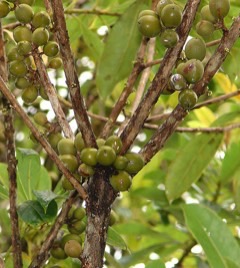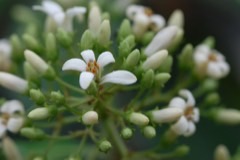 |
|
Dick Culbert wikimedia.org |
 |
| LiChieh Pan flickr.com |
Translate this page:
Summary
Sometimes misspelt as Pittosporum resinosum
Physical Characteristics

 Pittosporum resiniferum is an evergreen Tree growing to 25 m (82ft) by 20 m (65ft) at a medium rate.
Pittosporum resiniferum is an evergreen Tree growing to 25 m (82ft) by 20 m (65ft) at a medium rate.
See above for USDA hardiness. It is hardy to UK zone 10.
Suitable for: light (sandy), medium (loamy) and heavy (clay) soils and prefers well-drained soil. Suitable pH: mildly acid, neutral and basic (mildly alkaline) soils. It cannot grow in the shade. It prefers moist soil.
UK Hardiness Map
US Hardiness Map
Synonyms
This name is unresolved. Pittosporum resinosum (misspelt)
Plant Habitats
Edible Uses
References More on Edible Uses
Medicinal Uses
Plants For A Future can not take any responsibility for any adverse effects from the use of plants. Always seek advice from a professional before using a plant medicinally.
Leprosy
Herbalists in the Philippines use the petroleum nut as a universal medicine[360 ]. An infusion of the fruit is used as a remedy for intestinal and stomach pains[360 ]. An oleoresin obtained from the fruit is used externally as a cure for leprosy and other skin diseases; also to bring relief from muscular pains and skin diseases[360 , 418 ]. A decoction of the nuts is used in the treatment of colds[360 , 418 ]. The crushed nuts, combined with coconut oil, are used to bring relief from myalgia[360 ]. A decoction of the leaves is taken in the treatment of coughs[360 ]. The sap is used to treat ringworm[360 ].
References More on Medicinal Uses
The Bookshop: Edible Plant Books
Our Latest books on Perennial Plants For Food Forests and Permaculture Gardens in paperback or digital formats.

Edible Tropical Plants
Food Forest Plants for Hotter Conditions: 250+ Plants For Tropical Food Forests & Permaculture Gardens.
More

Edible Temperate Plants
Plants for Your Food Forest: 500 Plants for Temperate Food Forests & Permaculture Gardens.
More

More Books
PFAF have eight books available in paperback and digital formats. Browse the shop for more information.
Shop Now
Other Uses
An oil obtained from the fruit contains a dihydroterpene and also considerable quantities of normal heptane, which had only once before been found in nature, occurring in the digger pine (Pinus sabiniana) of California[345 ]. The oil can also be distilled into a very pure form of n-Heptane. Dihydroterpene is used in perfumes and medicines, whilst heptane is a component of gasoline, and has been suggested as a possible component of paint and varnish[269 ]. The oil is quite sticky, and in a thin layer rapidly becomes resinous[345 ]. In an open dish it burns strongly, with a sooty flame. It distils unchanged up to 165°, then with decomposition to give a resin oil. The oil distilling from100° to 165° is colourless, with an orange-like odour[345 ]. The essential oil is 8 - 10% of the total fruit weight and comprises 40% myrcene, 38% a-pinene, n-heptane and n-nonane are minor components[360 ]. The fruits, even green ones, burn brilliantly when ignited. Hence they are used like torch nuts or candlenuts for illumination in the bush[345 , 418 ]. The fruits are about 3cm long, borne in clusters on the stems[345 ]. The oil comes from the fruit, not the seed[360 ]. The nut has a carbon rating of 54, much higher than Jatropha curcas which has 41[360 ]. Carbon farming - Industrial Crop: hydrocarbon.
Special Uses
Carbon Farming
References More on Other Uses
Cultivation details
Experimental Crop Industrial Crop: Hydrocarbon Management: Standard
A plant of moderate to high elevations in the moist to wet tropics, where it can be found at elevations from 600 - 2,400 metres[303 , 418 ]. It grows best in areas where the mean annual temperature is within the range 18 - 28°c[418 ]. It prefers a mean annual rainfall in the range 1,500 - 5,000mm[418 ]. Prefers a well-drained soil[418 ]. The tree can commence fruiting when 6 - 12 metres tall[345 ]. Tree can commence bearing fruit within five years from seed[360 ]. One tree yields an average 250 - 300 kilos of fruit per year[360 ]. One litre of high flammable oil can be obtained from 15 kilos of fresh fruits[345 , 360 ]. There are considerable differences in the proportion of heptane and dihydroterpene found in the oil; the season and degree of ripeness of the fruits undoubtedly playing a considerable role in this respect[345 ]. All parts of the tree are distinctly resiniferous and have the same pleasant, orange-like odour as the fruits[345 ]. The flowers are fragrant[345 ]. Climate: tropical highlands. Humidity: humid. Cultivation: experimental. Management: standard.
Carbon Farming
-
Experimental Crop
Plant breeders are testing these plants to see if they could be domesticated for cultivation, but they are still in an experimental phase. Examples include milkweed and leafy spurge.
-
Industrial Crop: Hydrocarbon
Materials, chemicals and energy include bioplastics, rubber, biomass products gasoline, jet fuel, diesel, butane, propane, biogas. Plants are usually resprouting plants and saps.
-
Management: Standard
Plants grow to their standard height. Harvest fruit, seeds, or other products. Non-Destructive management systems.
References Carbon Farming Information and Carbon Sequestration Information
Temperature Converter
Type a value in the Celsius field to convert the value to Fahrenheit:
Fahrenheit:
The PFAF Bookshop
Plants For A Future have a number of books available in paperback and digital form. Book titles include Edible Plants, Edible Perennials, Edible Trees,Edible Shrubs, Woodland Gardening, and Temperate Food Forest Plants. Our new book is Food Forest Plants For Hotter Conditions (Tropical and Sub-Tropical).
Shop Now
Plant Propagation
Seed - The seed probably has a very short viability of less than 1 month[418 ]. Cuttings.
Other Names
If available other names are mentioned here
Pittosporum resiniferum, the resin cheesewood or petroleum nut. In the Philippine Cordilleras petroleum nut is locally known as apisang, abkel, abkol and da-il.
Native Range
TROPICAL ASIA: Malaysia (Sabah (Mt. Kinabalu)), Philippines
Weed Potential
Right plant wrong place. We are currently updating this section.
Please note that a plant may be invasive in one area but may not in your area so it's worth checking.
None Known
Conservation Status
IUCN Red List of Threatened Plants Status : This taxon has not yet been assessed

| Related Plants
|
| Latin Name | Common Name | Habit | Height | Hardiness | Growth | Soil | Shade | Moisture | Edible | Medicinal | Other |
| Pittosporum balansae | | Shrub | 3.0 |
-
| | LMH | SN | DM | 1 | 0 | |
| Pittosporum bicolor | Banyalla | Shrub | 5.0 |
8-11
| | LMH | SN | DM | 0 | 0 | 3 |
| Pittosporum crassifolium | Karo, Stiffleaf cheesewood | Shrub | 5.0 |
8-11
| | LM | SN | DM | 0 | 0 | 3 |
| Pittosporum eugenioides | Tarata | Tree | 10.0 |
8-11
| | LM | SN | DM | 1 | 1 | 1 |
| Pittosporum phillyreoides | Weeping Pittosporum, Narrow-leaf Pittosporum | Shrub | 4.5 |
9-11
| S | LM | N | DM | 2 | 1 | 2 |
| Pittosporum ralphii | Ralph's desertwillow | Shrub | 4.0 |
8-11
| | LM | N | DM | 0 | 0 | 3 |
| Pittosporum tenuifolium | Tawhiwhi | Tree | 7.0 |
7-10
| M | LM | SN | DM | 2 | 0 | 3 |
| Pittosporum tobira | Tobira, Japanese cheesewood, Australian Laurel, Mock Orange, Japanese Pittosporum | Shrub | 6.0 |
8-11
| F | LM | SN | DM | 0 | 0 | 3 |
| Pittosporum undulatum | Cheesewood, Australian cheesewood, Cheesewood, Pittosporum, Orange Berry Pittosporum, Victorian Box | Tree | 12.0 |
9-11
| F | LM | SN | DM | 0 | 0 | 3 |
|
Growth: S = slow M = medium F = fast. Soil: L = light (sandy) M = medium H = heavy (clay). pH: A = acid N = neutral B = basic (alkaline). Shade: F = full shade S = semi-shade N = no shade. Moisture: D = dry M = Moist We = wet Wa = water.
Now available:
Food Forest Plants for Mediterranean Conditions
350+ Perennial Plants For Mediterranean and Drier Food Forests and Permaculture Gardens.
[Paperback and eBook]
This is the third in Plants For A Future's series of plant guides for food forests tailored to
specific climate zones. Following volumes on temperate and tropical ecosystems, this book focuses
on species suited to Mediterranean conditions—regions with hot, dry summers and cool, wet winters,
often facing the added challenge of climate change.
Read More
Expert comment
Author
Hemsl.
Botanical References
Links / References
For a list of references used on this page please go here
A special thanks to Ken Fern for some of the information used on this page.
Readers comment
| Add a comment |
|
If you have important information about this plant that may help other users please add a comment or link below. Only comments or links that are felt to be directly relevant to a plant will be included. If you think a comment/link or information contained on this page is inaccurate or misleading we would welcome your feedback at [email protected]. If you have questions about a plant please use the Forum on this website as we do not have the resources to answer questions ourselves.
* Please note: the comments by website users are not necessarily those held by PFAF and may give misleading or inaccurate information.
To leave a comment please Register or login here All comments need to be approved so will not appear immediately.
|
Subject : Pittosporum resiniferum
|
|
|
|